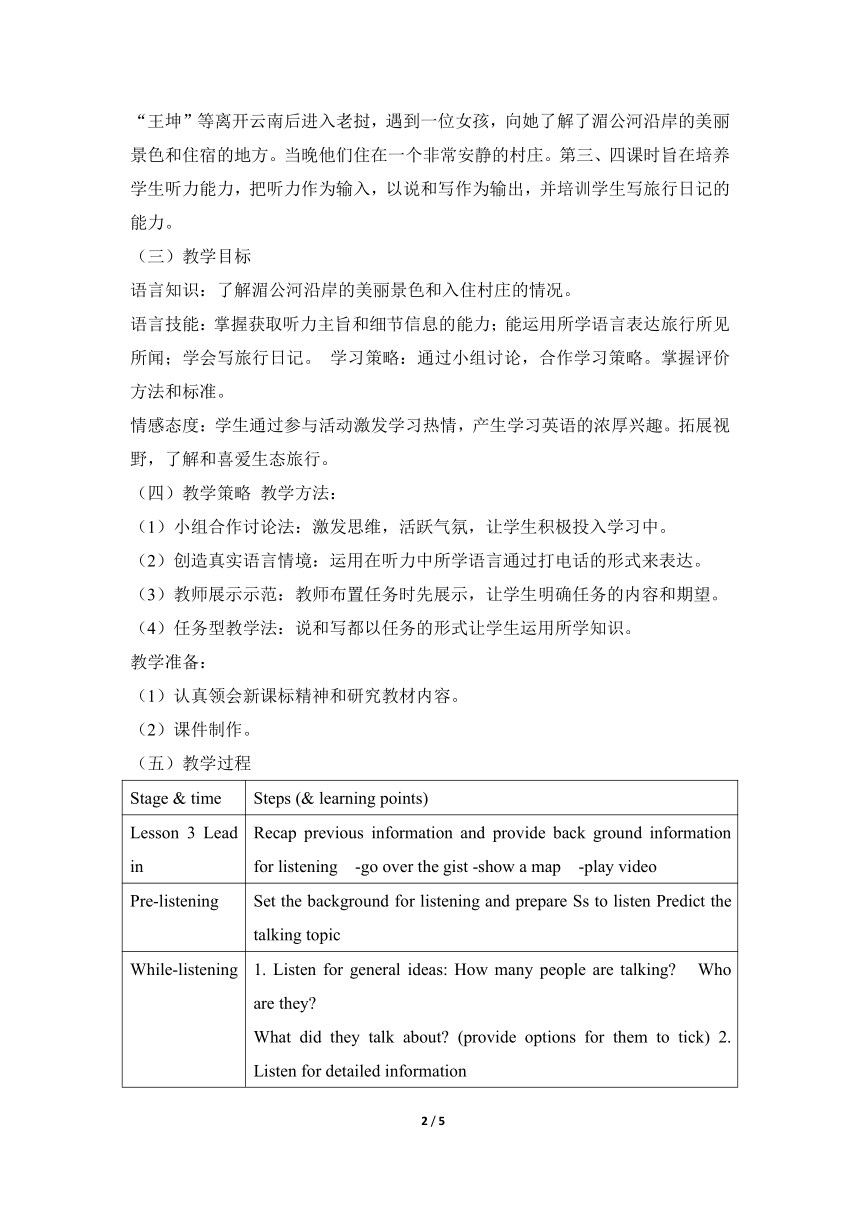人教版英语必修1 Unit3 Travel journal听说课 公开课教学设计
文档属性
| 名称 | 人教版英语必修1 Unit3 Travel journal听说课 公开课教学设计 |  | |
| 格式 | doc | ||
| 文件大小 | 50.5KB | ||
| 资源类型 | 教案 | ||
| 版本资源 | 人教版(新课程标准) | ||
| 科目 | 英语 | ||
| 更新时间 | 2021-07-23 10:47:57 | ||
图片预览


文档简介
Unit 3 听说课 公开课教学设计
Topic: Unit 3 Travel Journal
Lesson Plan for 3 and 4 period (Listening, Speaking and Writing)
听力、口语、写作课教学设计
授课内容:Unit 3 Travel Journal 第三、四课时听力、口语、写作课设计
授课时间:45分钟 (备注:录像课为第四课时)
(一) 学生分析
学生年龄大多在16-17岁,已意识到英语的重要性,希望学好英语,但对英语的兴趣并不是很浓厚。中考全班英语平均分约60分,他们通过初中三年的学习,相当部分同学已具有一定的听说读写能力、自主学习能力和分析能力,但一部分学生存在回答问题时声音太小,不敢大胆表达自己观点,怕出现错误,根据高中教学的要求,仍需要进一步的提高,特别是听力、口语和写作能力。 本单元的中心话题是“旅游”,可以说这是一个世界性的时尚话题,随着经济发展、社会进步、人们生活水平的提高,旅游作为现代人的一种生活方式,越来越被更多的人们所接受与喜爱。学生对旅行比较感兴趣,旅行经验不是很丰富。通过对本单元第一、二部分的学习,对湄公河背景知识有一定的了解,他们渴望了解河流流经国家的相关情况。
(二) 教材分析
1.本课所处本单元的位置
这是本单元的第三、四课时,是一节听力、口语、写作课。
2.课前的学习内容与本节内容的内在联系
本单元讲述了一段沿湄公河而下的自行车旅行, 主人公“王坤”以旅行日记的形式详细的记录了这一过程。学习了单元的第一、二课时,同学们已经了解了湄公河的背景知识和旅行路线,为这节课做好了铺垫。
3.对教材的处理
教材要求学生具备一定听说写能力,以路线为单元主线设计听说写课时。主人公“王坤”等离开云南后进入老挝,遇到一位女孩,向她了解了湄公河沿岸的美丽景色和住宿的地方。当晚他们住在一个非常安静的村庄。第三、四课时旨在培养学生听力能力,把听力作为输入,以说和写作为输出,并培训学生写旅行日记的能力。
(三)教学目标
语言知识:了解湄公河沿岸的美丽景色和入住村庄的情况。
语言技能:掌握获取听力主旨和细节信息的能力;能运用所学语言表达旅行所见所闻;学会写旅行日记。 学习策略:通过小组讨论,合作学习策略。掌握评价方法和标准。
情感态度:学生通过参与活动激发学习热情,产生学习英语的浓厚兴趣。拓展视野,了解和喜爱生态旅行。
(四)教学策略 教学方法:
(1)小组合作讨论法:激发思维,活跃气氛,让学生积极投入学习中。
(2)创造真实语言情境:运用在听力中所学语言通过打电话的形式来表达。
(3)教师展示示范:教师布置任务时先展示,让学生明确任务的内容和期望。
(4)任务型教学法:说和写都以任务的形式让学生运用所学知识。
教学准备:
(1)认真领会新课标精神和研究教材内容。
(2)课件制作。
(五)教学过程
Stage & time Steps (& learning points)
Lesson 3 Lead in Recap previous information and provide back ground information for listening -go over the gist -show a map -play video
Pre-listening Set the background for listening and prepare Ss to listen Predict the talking topic
While-listening 1. Listen for general ideas: How many people are talking? Who are they?
What did they talk about? (provide options for them to tick) 2. Listen for detailed information
3. Listen and choose the correct main idea
Post-listening Read aloud
Lesson 4 Set the scene (10mins.)
1. Tell Ss the young travelers continued their journey after talking with the Laotian girl. On their third night, they slept in a small village.
2. Play a small part of listening taken from
Part 4: Our journey through Laos
Speaking (20mins.)
Tell the situation
It was very quiet at night but Wang Kun can抰 sleep because of the noise of the truck and the sound of the river. So he decided to call a friend in China and talk about his journey in Laos. Work to do
1. Ss have to work in pairs to write the dialogue, then role-play in front of the class 2. Ss are given the dialogue structure to work on:
Friend
Where are you? Have you met your cousins?
Wang Kun
Yes, we joined with them in Yunnan. We then cycled together down the river.
Friend
Where are you now?
Wang Kun
We are now in
We arrived here three days ago. On the first day we came here, we met
She told me a lot of things about Laos.
Friend
What did she tell you?
Wang Kun
She told me:
(another name of the Mekong)
(importance of Mekong)
Friend
So the Mekong is as important to the Laotians as the Yellow River is to us.
What else did she tell you?
Wang Kun
She also told me:
(where to go) -
(where to stay)
Friend
You are staying in a village for the night.
Wang Kun
Yes, it抯 very quiet here - wo quiet I can hear (truck and river)
3. Allow time for Ss to practice
Writing (10mins.) 1. Introduce how to write a travel journal and provide Ss with the journal structure
2. Write the first part together with the ss together and ask them to finish the rest as homework
Evaluation (5mins.)
教学反思:
1.教学始终要以学生为本,设计要符合学生认知情况,这样才能激发他们的学习兴趣,与学生之前的背景知识相联系。
2.课堂设计要预测课堂上学生可能遇到的困难,提前设计好问题或活动一步步引导学生掌握知识。
3.课堂小组活动活跃,但组织不够严密,效率提升有进一步空间。
4.要帮助学生做好形成性评价,有利于老师和学生了解学习情况,并对以后的教学提供信息。
5.写作部分设计还要继续完善,向学生展示老师是如何合并的。
4 / 5
Topic: Unit 3 Travel Journal
Lesson Plan for 3 and 4 period (Listening, Speaking and Writing)
听力、口语、写作课教学设计
授课内容:Unit 3 Travel Journal 第三、四课时听力、口语、写作课设计
授课时间:45分钟 (备注:录像课为第四课时)
(一) 学生分析
学生年龄大多在16-17岁,已意识到英语的重要性,希望学好英语,但对英语的兴趣并不是很浓厚。中考全班英语平均分约60分,他们通过初中三年的学习,相当部分同学已具有一定的听说读写能力、自主学习能力和分析能力,但一部分学生存在回答问题时声音太小,不敢大胆表达自己观点,怕出现错误,根据高中教学的要求,仍需要进一步的提高,特别是听力、口语和写作能力。 本单元的中心话题是“旅游”,可以说这是一个世界性的时尚话题,随着经济发展、社会进步、人们生活水平的提高,旅游作为现代人的一种生活方式,越来越被更多的人们所接受与喜爱。学生对旅行比较感兴趣,旅行经验不是很丰富。通过对本单元第一、二部分的学习,对湄公河背景知识有一定的了解,他们渴望了解河流流经国家的相关情况。
(二) 教材分析
1.本课所处本单元的位置
这是本单元的第三、四课时,是一节听力、口语、写作课。
2.课前的学习内容与本节内容的内在联系
本单元讲述了一段沿湄公河而下的自行车旅行, 主人公“王坤”以旅行日记的形式详细的记录了这一过程。学习了单元的第一、二课时,同学们已经了解了湄公河的背景知识和旅行路线,为这节课做好了铺垫。
3.对教材的处理
教材要求学生具备一定听说写能力,以路线为单元主线设计听说写课时。主人公“王坤”等离开云南后进入老挝,遇到一位女孩,向她了解了湄公河沿岸的美丽景色和住宿的地方。当晚他们住在一个非常安静的村庄。第三、四课时旨在培养学生听力能力,把听力作为输入,以说和写作为输出,并培训学生写旅行日记的能力。
(三)教学目标
语言知识:了解湄公河沿岸的美丽景色和入住村庄的情况。
语言技能:掌握获取听力主旨和细节信息的能力;能运用所学语言表达旅行所见所闻;学会写旅行日记。 学习策略:通过小组讨论,合作学习策略。掌握评价方法和标准。
情感态度:学生通过参与活动激发学习热情,产生学习英语的浓厚兴趣。拓展视野,了解和喜爱生态旅行。
(四)教学策略 教学方法:
(1)小组合作讨论法:激发思维,活跃气氛,让学生积极投入学习中。
(2)创造真实语言情境:运用在听力中所学语言通过打电话的形式来表达。
(3)教师展示示范:教师布置任务时先展示,让学生明确任务的内容和期望。
(4)任务型教学法:说和写都以任务的形式让学生运用所学知识。
教学准备:
(1)认真领会新课标精神和研究教材内容。
(2)课件制作。
(五)教学过程
Stage & time Steps (& learning points)
Lesson 3 Lead in Recap previous information and provide back ground information for listening -go over the gist -show a map -play video
Pre-listening Set the background for listening and prepare Ss to listen Predict the talking topic
While-listening 1. Listen for general ideas: How many people are talking? Who are they?
What did they talk about? (provide options for them to tick) 2. Listen for detailed information
3. Listen and choose the correct main idea
Post-listening Read aloud
Lesson 4 Set the scene (10mins.)
1. Tell Ss the young travelers continued their journey after talking with the Laotian girl. On their third night, they slept in a small village.
2. Play a small part of listening taken from
Part 4: Our journey through Laos
Speaking (20mins.)
Tell the situation
It was very quiet at night but Wang Kun can抰 sleep because of the noise of the truck and the sound of the river. So he decided to call a friend in China and talk about his journey in Laos. Work to do
1. Ss have to work in pairs to write the dialogue, then role-play in front of the class 2. Ss are given the dialogue structure to work on:
Friend
Where are you? Have you met your cousins?
Wang Kun
Yes, we joined with them in Yunnan. We then cycled together down the river.
Friend
Where are you now?
Wang Kun
We are now in
We arrived here three days ago. On the first day we came here, we met
She told me a lot of things about Laos.
Friend
What did she tell you?
Wang Kun
She told me:
(another name of the Mekong)
(importance of Mekong)
Friend
So the Mekong is as important to the Laotians as the Yellow River is to us.
What else did she tell you?
Wang Kun
She also told me:
(where to go) -
(where to stay)
Friend
You are staying in a village for the night.
Wang Kun
Yes, it抯 very quiet here - wo quiet I can hear (truck and river)
3. Allow time for Ss to practice
Writing (10mins.) 1. Introduce how to write a travel journal and provide Ss with the journal structure
2. Write the first part together with the ss together and ask them to finish the rest as homework
Evaluation (5mins.)
教学反思:
1.教学始终要以学生为本,设计要符合学生认知情况,这样才能激发他们的学习兴趣,与学生之前的背景知识相联系。
2.课堂设计要预测课堂上学生可能遇到的困难,提前设计好问题或活动一步步引导学生掌握知识。
3.课堂小组活动活跃,但组织不够严密,效率提升有进一步空间。
4.要帮助学生做好形成性评价,有利于老师和学生了解学习情况,并对以后的教学提供信息。
5.写作部分设计还要继续完善,向学生展示老师是如何合并的。
4 / 5
